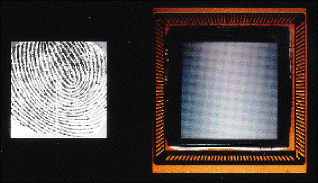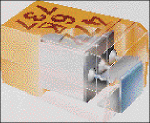1997 Editors' Roundup:
Components and optoelectronics
Marked by significant technological strides, the year 1997 saw a continued
trend toward increased device portability and improved performance at lower
costs. Although the products chosen as Products of the Year exemplify this,
other advancements should be noted.
Semiconductor manufacturer SGS-Thomson (Lincoln, MA) developed a CMOS
sensor array that directly registers and produces a digital image of a
fingerprint (see Electronic Products , Aug. 1997, p. 21).

SGS-Thomson STFP2015-50
The company's first product offering–the STFP2015-50 biometric sensor–integrates
all required components for the subsystem in a 35 x 35 x 5-mm package.
Because of its size, a 200-mW power consumption at 6 to 20 V, and a target
price of $50 each in quantities of 1,000, the sensor can be integrated
into a slew of products including notebooks, mobile phones, and ATMs.
After 10 years of research, Dpix (Palo Alto, CA), announced the FlashScan
20 Imaging Subsystem (see Electronic Products , March 1997, p. 18),
a digital-image sensor array that has a resolution and sensitivity that
can replace x-ray film for flash-image capture. The subsystem offers real-time
testing, diagnosis, and consultation for medical applications from anywhere
in the world.
The year had a great deal to offer in discrete semiconductors, as well.
The industry experienced continuous improvement in several areas, including
on-resistance, current capability, and switching speed.
The Si4720CY battery-disconnect switch–introduced by Temic Semiconductors
(Santa Clara, CA)–integrates p-channel MOSFETs and level-shift circuitry
in an SO-16 (see Electronic Products , March 1997, p. 112). It eliminates
common parasitic diode problems that are associated with MOSFETs and extends
battery run time by controlling battery switching with the microprocessor's
3.3 or 5-V rail.
International Rectifier (El Segundo, CA) introduced the Warp Speed Series
of IGBTs (see Electronic Products , Aug. 1997, p. 90), which match
the switching characteristics of large MOSFETs. The IGBTs are capable of
hard switching at up to 150 kHz and resonant switching to over 300 kHz.
Fairchild Semiconductor (Santa Clara, CA) produced the FD series–a
cost-competitive MOSFET replacement for bipolar transistors in digital
circuits (see Electronic Products , Sept. 1997, p113). The devices
extend battery run time because they don't draw bias current or require
bias resistors, which reduces component count.
In passive components, AVX (Myrtle Beach, SC) released the TACmicrochip
Series of tantalum capacitors and was able to pack the industry's highest
volumetric efficiency into a 0603 chip size (see Electronic Products ,
April 1997, p. 54). The surface-mount capacitors come in values ranging
from 1.0 µF at 10 V to 4.7 µF at 2 V and feature ESRs as low
as 10 ohm at 100 kHz.
Later in the year, Kemet (Green- ville, SC) announced a breakthrough
in solid-tantalum capacitor technology that enables the lowest ESR in an
industry-standard EIA 7343H package (see Electronic Products , Nov.
1997, p. 23).

Kemet T510
Rated at 6 V and 470 µF, the first product offering in the T510
Series features an ESR of 30 milliohm at 100 kHz and has a ripple current
capability of up to 3 Arms.
–Sharon Richardson
Advertisement





